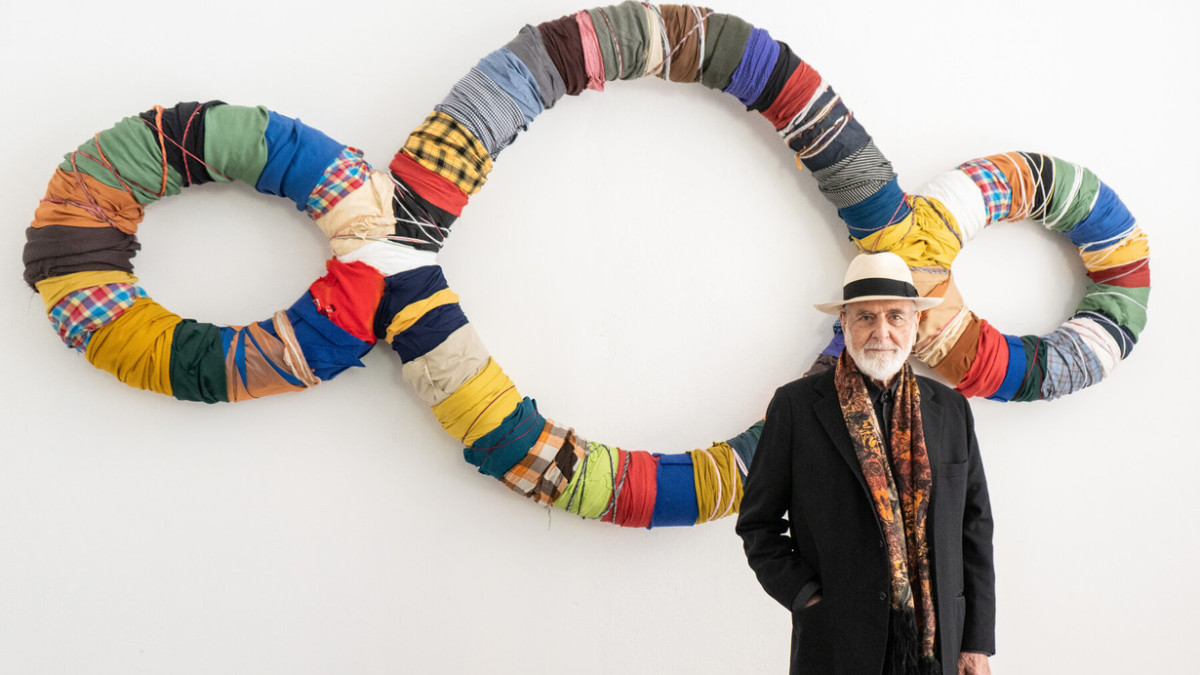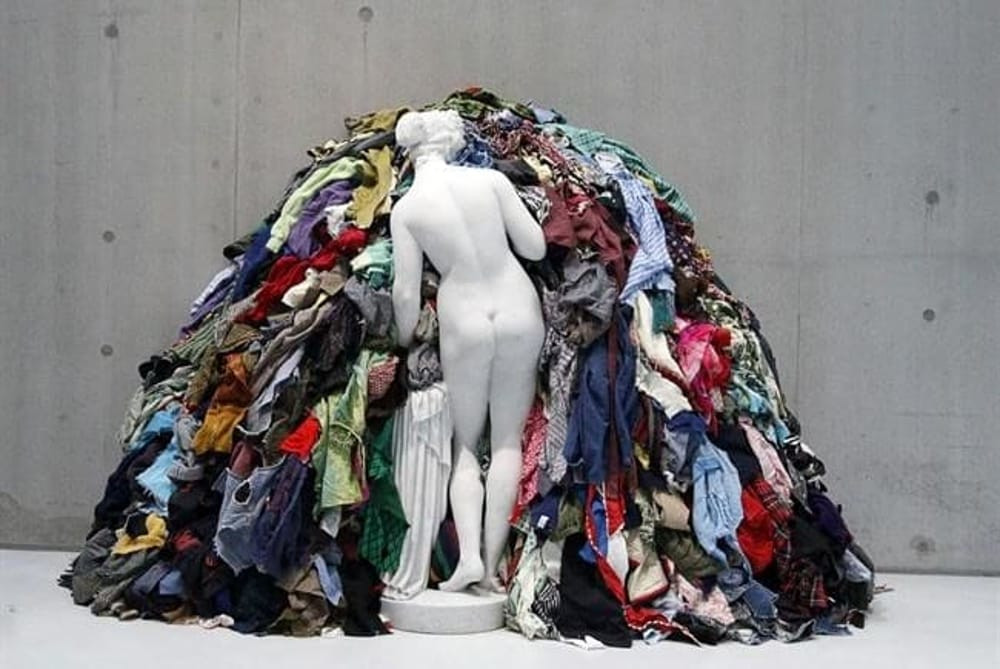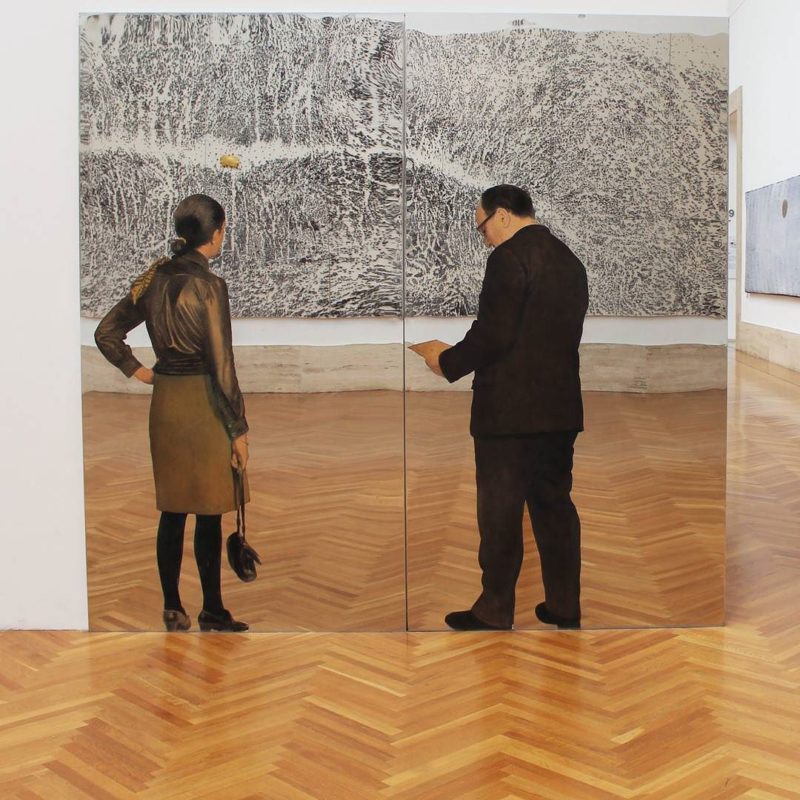
LIFE AND WORKS OF MICHELANGELO PISTOLETTO: 5 THINGS TO KNOW
Describing the life and works of Michelangelo Pistoletto means understanding a piece of 20th century art history.
Pistoletto is an Italian artist born in Biella in 1933 and is considered one of the main exponents of Arte Povera, an art movement that originated in Italy in the 1960s and 1970s.
Life and works of Michelangelo Pistoletto

Venere degli stracci
Michelangelo Pistoletto’s works consist of paintings, sculptures, installations and performances. However, he is mainly known for his conceptual works and his involvement in social art and public art practice.
1. ART BY MICHELANGELO PISTOLETTO
Among Pistoletto’s most famous works are the ‘Mirror-paintings’, which consist of large reflective metal panels with images of people or objects that seem to float in space. The characteristic of these works is that they are interactive and involve the viewer through the reflection of their images.
Pistoletto, however, is not only an artist but also a promoter of art and is the founder of Cittadellarte-Fondazione Pistoletto, a centre for interdisciplinary research and cultural production that promotes art, education and sustainable development in his home town of Biella.
2. LIFE OF MICHELANGELO PISTOLETTO
Michelangelo Pistoletto grew up in a family of artists and started drawing and painting at an early age. In 1947, when he was only 14 years old, he attended the Albertina Academy of Fine Arts in Turin, where he studied drawing and painting.
In the 1950s, Pistoletto started to exhibit his work in art exhibitions in Turin and other Italian cities. In 1960, he founded an art movement called ‘Arte Povera’, which sought to create works of art using poor and common materials.
In 1962, Pistoletto began working with sheets of reflective metal, which he used to create his most famous works, the ‘Mirror Paintings’. These works, along with other creations, have made Pistoletto one of the most important artists in contemporary art.
Over the years, Pistoletto has continued to exhibit his works in exhibitions and museums all over the world. He has also participated in numerous cultural and social initiatives, using his art as a tool to promote social change.
In his worldview, culture, art and the environment are integrated to create a more just and sustainable society.
3. WORKS BY MICHELANGELO PISTOLETTO
Michelangelo Pistoletto has created many important works throughout his career.
Here are some of his most significant works:
- “Mirror paintings”: this series of mirror works is one of Pistoletto’s best known. Their combination of image and reflection challenges the viewer’s perception and actively involves him in the work.
- “Venus of rags”: this sculpture, created in 1967, depicts the goddess Venus next to a large mountain of rags, representing the consumer society and is a critical reflection on the excessive habits of consumerism.
- “The Bird Cage”: realised in 1966, this installation consists of a rectangular cage in which some birds perch on green branches, together with a black car. The work represents the contrast between the freedom of nature and the limitation imposed by human civilisation.
- “The Third Paradise”: this work, created in 2003, represents a symbol in which the first paradise represents nature, the second the artificial world, and the third the synthesis between the two, i.e. the possibility of a world in which nature and technology can coexist in balance.
- “The Blessed Sixties”: this performance, realised in 1964, involved the creation of a 1960s living environment inside an art gallery. The work is a critique of contemporary society and the superficiality of mass culture.
These are just a few of Michelangelo Pistoletto’s most important works, but his artistic output is vast and has addressed issues of great social and cultural impact.

quadri specchianti
4. PISTOLETTO’S MIRROR PAINTINGS
Michelangelo Pistoletto’s mirror paintings are a significant part of his artistic production. The earliest date back to 1962, when Pistoletto began using sheets of reflective metal to create mirror surfaces within his works.
Pistoletto’s most famous series of mirror works is called ‘Mirror Paintings’.
These works consist of large panels of reflective metal on which images of objects, people or landscapes are printed. The effect is to create a surface that incorporates the reflection of the viewer within the work itself.
Pistoletto’s ‘Mirror-paintings’ give new meaning to the use of the mirror in art and are considered interactive works, as the viewer becomes an integral part of the work itself through the reflection of his own face and body. This active involvement of the public is an important element of conceptual art and Arte Povera, the art movement of which Pistoletto is one of the main exponents.
5. WHY PISTOLETTO IS IMPORTANT
Michelangelo Pistoletto is an important artist for several reasons.
Firstly, he has contributed significantly to the evolution of contemporary art, proposing new techniques and modes of expression.
In particular, his series of mirror works, the ‘Mirror Paintings’, represented a turning point in conceptual art, challenging the viewer’s perception and actively involving him in the work.
Furthermore, Pistoletto has always used his art as a tool to promote social and cultural change, engaging in projects that go beyond the art world. This is why he created the Cittadellarte – Fondazione Pistoletto, a centre for research and cultural production that promotes art, education and sustainable development, demonstrating his concern for environmental and social issues.
Finally, Pistoletto was a pioneer of Arte Povera, an art movement that revolutionised the art world of the 1960s and 1970s by creating works of art using poor and common materials. Arte Povera was a response to the artworks produced in the context of contemporary art at the time, which were sometimes considered too distant from real life.
For all these reasons, Michelangelo Pistoletto is considered one of the most important contemporary artists, who influenced 20th century art history and helped to promote a more social and engaged approach in art.


Abito a Torino. Ho incontrato il Maestro all’angolo dell’Accademia Albertina, Mi ha guardato facendomi un mezzo sorriso, forse capendo che avrei voluto tanto fermarmi e salutarlo, parlare dell’ arte che produco io e sentire il suo parere,ma…non ho avuto il coraggio, ho temuto di dosturbare. Buon lavoro, maestro.
Io l’ho visto qualche anno fa durante l’inaugurazione di una sua mostra a Venezia. Avrei voluto intervistarlo ma ho avuto un po’ di timore e alla fine ho rinunciato e ho usato il comunicato stampa ufficiale per scrivere un articolo.
E’ un uomo di grande carisma ma incute anche un timore reverenziale perchè ciò che ha fatto e continua a fare è grande!
Buongiorno prof. Michelangelo Pistoletto
sono Maria Santa Guarini, l’ammiro fortemente per i suoi grandi lavori e condivido pienamente il suo pensiero che cultura, arte e ambiente creano una società più sostenibile e in merito a questo l’ Associazione “Integrante “ha promosso una collettiva d’arte, come strumento per la promozione del cambiamento sociale, dove gli artisti grandi creatori ed educatori presenteranno i 17 obiettivi dell’Agenda 2030 :Diritti Universali.. Noi del Direttivo saremmo molto contenti se ci onorasse della sua presenza. anche perché farebbe un omaggio a Gianni Rodari :”Filastrocche e Racconti in gioco senza frontiere tra versi, colori, forme e scatti, Dalla poesia alla tela , 17 obiettivi dell’Agenda 2030, I Diritti Universali, Omaggio a Gianni Rodari”
Impazienti aspettiamo un riscontro positivo.
Cordiali saluti
Maria Santa Guarini
Presidente dell’Associazione “Integrando”
Questo non è il sito ufficiale di Michelangelo Pistoletto!